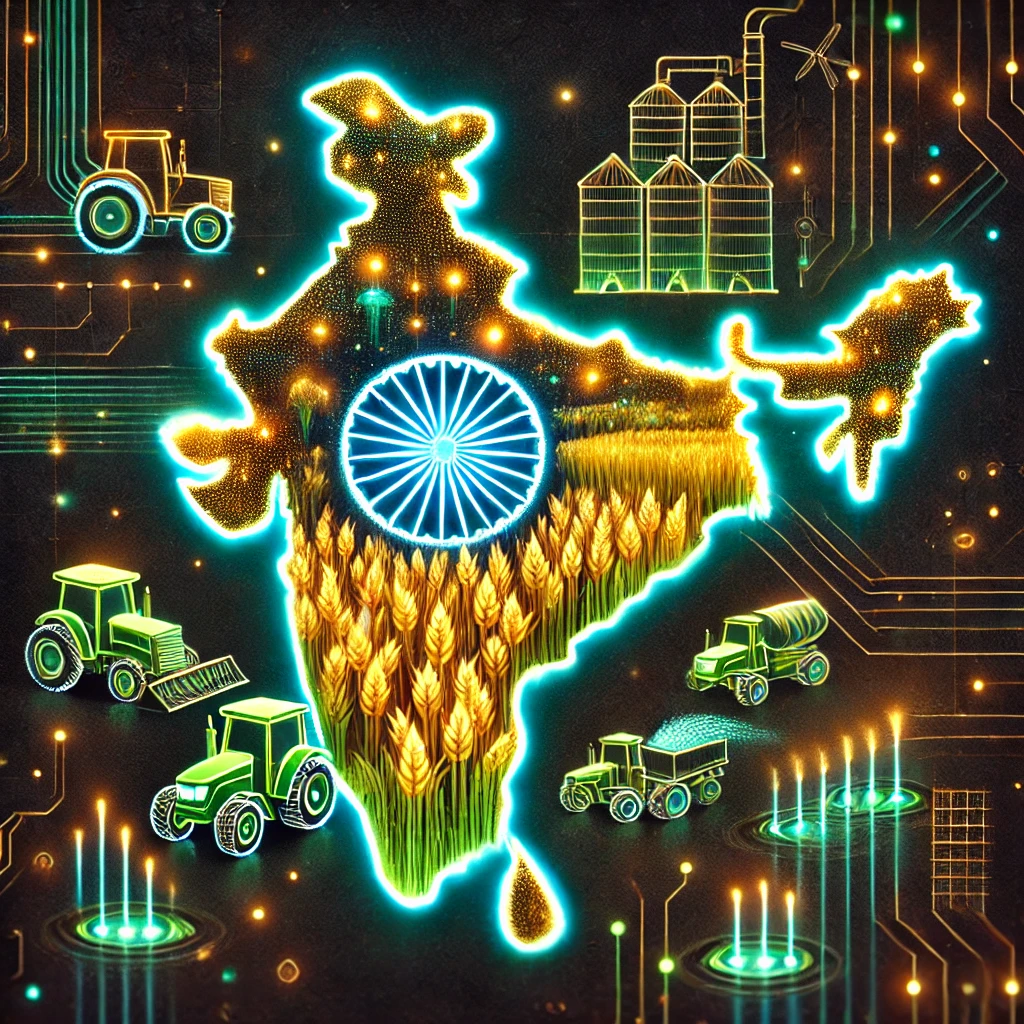Introduction
Agriculture has historically been the backbone of India’s economy, providing livelihood to a significant portion of the population and playing a crucial role in economic growth. Despite rapid industrialization and the expansion of the services sector, agriculture remains a vital contributor to India’s GDP, employment, and overall socio-economic development. However, the sector faces numerous challenges, ranging from climate change and resource scarcity to policy constraints and market inefficiencies.
This article explores the role of agriculture in India’s economic development, its contributions to employment, GDP, and rural livelihoods, and the major challenges that the sector faces today.
The Role of the Agricultural Sector in India’s Economic Development
1. Contribution to GDP
Agriculture has been a significant contributor to India’s Gross Domestic Product (GDP). While its share in GDP has declined over the decades due to the rapid growth of the industrial and service sectors, it still holds considerable importance. In recent years, agriculture has contributed around 15-18% to India’s GDP.
The Green Revolution in the 1960s transformed India from a food-deficient country to a self-sufficient one. This period saw significant growth in agricultural productivity due to the adoption of high-yielding varieties of seeds, chemical fertilizers, and improved irrigation techniques. Today, agriculture remains a critical economic driver, particularly in rural areas where the majority of India’s population resides.
2. Employment Generation
Agriculture is the largest source of employment in India, providing livelihoods to more than 40% of the workforce. This sector supports not just farmers but also laborers, small traders, and workers in agro-based industries. Rural employment depends heavily on agriculture, with millions engaged in farming, animal husbandry, and related activities.
Despite a shift towards industrial and service sector jobs, a vast section of India’s population still relies on agriculture for their livelihood. Government initiatives such as the Mahatma Gandhi National Rural Employment Guarantee Act (MGNREGA) have further strengthened the agricultural labor force by providing wage employment opportunities in rural areas.
3. Contribution to Industrial Growth
Agriculture plays a fundamental role in supporting industrial growth by supplying raw materials to various industries. Several industries, including textiles, sugar, food processing, and dairy, depend on agricultural products such as cotton, sugarcane, wheat, rice, and milk.
The agro-processing industry has also gained momentum, contributing to value addition, employment generation, and export earnings. The growth of food processing industries has helped in reducing post-harvest losses, increasing farmers’ incomes, and ensuring better market access for agricultural products.
4. Food Security and Self-Sufficiency
One of the most significant contributions of agriculture to India’s economic development is ensuring food security. The Green Revolution played a crucial role in making India self-sufficient in food grain production, reducing dependence on food imports. The production of wheat, rice, pulses, and other staples has increased substantially, ensuring that the growing population has access to adequate food supplies.
The government has also implemented several policies, such as the Public Distribution System (PDS) and the National Food Security Act (NFSA), to ensure that food reaches vulnerable sections of society. These initiatives depend on the stable growth of agricultural production.
5. Foreign Exchange Earnings through Exports
Agricultural exports contribute significantly to India’s foreign exchange earnings. India is one of the world’s largest exporters of rice, spices, tea, coffee, and marine products. The export of agricultural products has seen steady growth due to increasing global demand, improved infrastructure, and government support under schemes like the Agricultural Export Policy and Market Access Initiatives.
With a focus on organic farming, high-value crops, and processed agricultural goods, India has the potential to further expand its global agricultural exports, enhancing rural incomes and economic growth.
6. Role in Rural Development
Agriculture is the primary driver of rural development in India. The majority of India’s population lives in rural areas, where farming is the main economic activity. The development of agriculture leads to rural prosperity, improving infrastructure, employment opportunities, and access to education and healthcare.
Government initiatives like rural electrification, irrigation projects, and rural credit schemes have strengthened the agricultural sector and contributed to overall rural development.
7. Sustainable Development and Environmental Protection
Sustainable agricultural practices play a crucial role in environmental conservation. The promotion of organic farming, watershed management, afforestation, and soil conservation helps in maintaining ecological balance. Sustainable agriculture ensures that natural resources such as soil and water are preserved for future generations while meeting the needs of the present population.
Major Challenges Faced by the Agricultural Sector in India
Despite its importance, the agricultural sector in India faces several challenges that hinder its growth and sustainability. Some of the most pressing issues include:
1. Small and Fragmented Landholdings
One of the biggest challenges in Indian agriculture is the fragmentation of land. Due to inheritance laws, agricultural land is divided into smaller plots, making it difficult for farmers to achieve economies of scale. Small landholdings lead to lower productivity, limited mechanization, and increased costs of cultivation.
2. Dependence on Monsoon and Climate Change
A significant portion of Indian agriculture is rain-fed, making it highly dependent on monsoon rains. Unpredictable weather patterns, droughts, floods, and extreme climatic conditions pose serious risks to agricultural production. Climate change has exacerbated these challenges, leading to irregular rainfall, rising temperatures, and increasing frequency of natural disasters.
3. Low Agricultural Productivity
Despite technological advancements, India’s agricultural productivity remains lower than that of developed countries. Factors such as outdated farming techniques, low mechanization, poor soil health, and lack of access to quality seeds and fertilizers contribute to this issue. Improving productivity through modern technology and research is crucial for the sector’s growth.
4. Inadequate Irrigation Facilities
Although irrigation coverage has increased over the years, many farmers still rely on rain-fed agriculture. A lack of proper irrigation infrastructure limits the ability of farmers to cultivate crops year-round. Expanding irrigation coverage through canal networks, efficient water management, and micro-irrigation techniques (such as drip and sprinkler irrigation) is essential.
5. Post-Harvest Losses and Lack of Storage Facilities
Post-harvest losses due to inadequate storage, poor transportation, and inefficient supply chains result in significant wastage of food grains, fruits, and vegetables. Cold storage facilities and better logistics infrastructure are necessary to reduce these losses and ensure that farmers get fair prices for their produce.
6. Market Access and Price Fluctuations
Farmers often struggle with market access due to a lack of proper transportation and connectivity. Price fluctuations caused by supply-demand imbalances, hoarding, and government policies create uncertainty for farmers. The Minimum Support Price (MSP) system helps to some extent, but a more efficient market mechanism is needed to protect farmers from price volatility.
7. Lack of Credit and Financial Support
Access to credit is a major issue for small and marginal farmers. Many rely on informal sources of credit, which charge high-interest rates. Although government schemes like the Kisan Credit Card (KCC) and agricultural loans have improved financial inclusion, more efforts are needed to ensure easy and timely credit availability.
8. Rising Input Costs
The cost of agricultural inputs such as fertilizers, seeds, pesticides, and machinery has been rising steadily. Small farmers often struggle to afford these inputs, leading to reduced profitability. Government subsidies and cost-effective farming techniques are necessary to alleviate this burden.
9. Land Degradation and Soil Erosion
Excessive use of chemical fertilizers, pesticides, and intensive farming practices have led to soil degradation and loss of fertility. Sustainable farming methods, including organic farming, crop rotation, and soil conservation techniques, must be promoted to ensure long-term productivity.
Conclusion
Agriculture remains a vital pillar of India’s economic development, contributing to employment, GDP, food security, and rural prosperity. However, the sector faces multiple challenges that require immediate attention and policy interventions.
To ensure the sustainable growth of agriculture, India must focus on modernizing farming techniques, improving irrigation, expanding market access, and implementing policies that enhance farmers’ incomes. By addressing these challenges, agriculture can continue to drive economic progress and support the overall development of the country.




